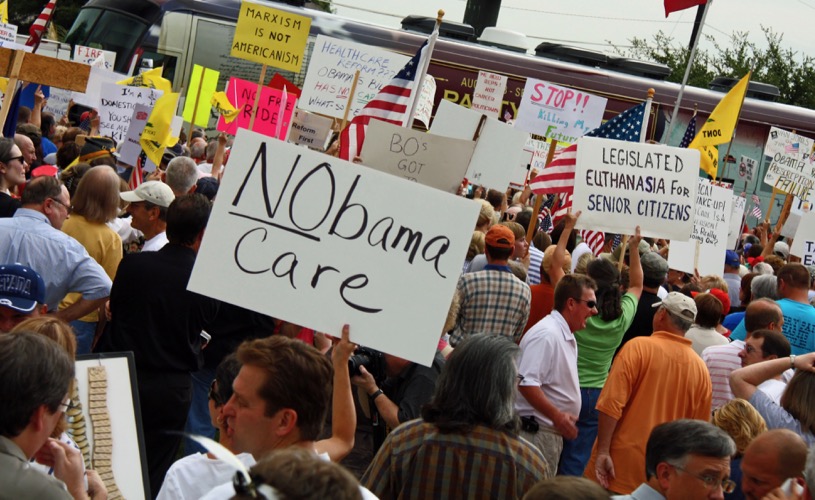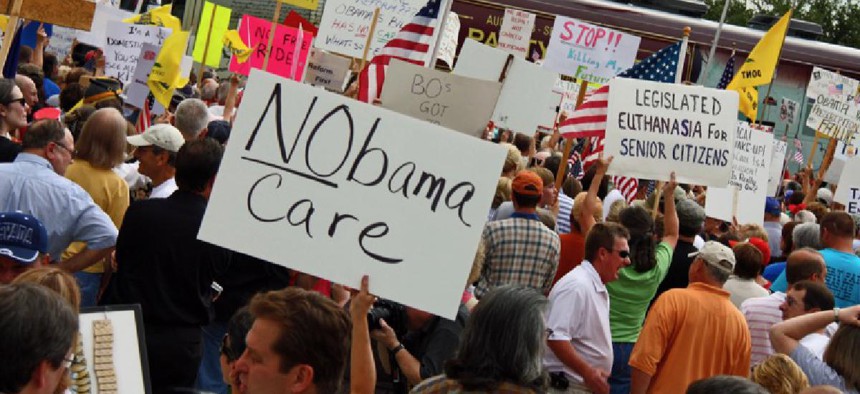 Protesters rally against Obamacare. (Ken Durden/Shutterstock.com)
Protesters rally against Obamacare. (Ken Durden/Shutterstock.com)
This past year has to be considered a big success on the health front for New York progressives. Paid family leave was signed into law, the tampon tax was repealed and hundreds of thousands of people signed up for coverage under the state health care exchange for the first time.
But despite all of those accomplishments, for Democrats 2017 looks to be less about making progressive gains and more about defending their turf in the wake of Donald Trump’s surprising presidential election victory, a Republican Congress and a split state Senate.
With Trump signaling that he will attempt to repeal major portions of the Affordable Care Act, New York Democrats are rushing to prepare alternatives for the 2.8 million New Yorkers insured on the New York State of Health marketplace as well as deal with a potentially massive budget hole of up to $800 million.
The potential budget shortfall stems from the state’s use of a “basic health plan” under the Affordable Care Act, which provides heavily subsidized insurance from the federal government to hundreds of thousands of New Yorkers who do not qualify for Medicaid. Assemblyman Richard Gottfried sees the potential budget deficit as one of the most important issues New York officials will have to confront in regards to the Trump presidency.
One option Gottfried suggested may be used to help solve the shortfall would be to increase the cap on state Medicaid spending, which currently sits at $17.7 billion, according to the state Department of Health. However, the differing start times for the new legislative and congressional sessions could make it harder to figure out how big the budget gap will be.
“We will not know for sure what the federal government is going to do, because Trump will just be getting sworn in,” Gottfried said. “I certainly don’t know what the governor will do (in his annual budget proposal), and I’m not sure he has made a decision on that.”
Another issue the state Legislature may tackle in preparation for a Trump presidency is the codifying of Roe v. Wade in the state’s constitution, in the event the landmark abortion decision is overturned by a Supreme Court reshaped by Trump. However, attempts to pass such legislation have failed in recent years when it was included in the 10-part Women's Equality Act.
A number of laws passed in previous sessions could also see expansion. Following the passage of a law lifting the of statute of limitations for lawsuits related to water contamination sites this past session, the Assembly and state Senate held hearings in September to investigate the water contamination crises in Hoosick Falls and Newburgh. Lawmakers may now look to pass more legislation to protect drinking water, such as mandating an increase in water testing.
“The main thing now is that New Yorkers in general and the executive branch have seen that the medical marijuana program is a secure program and that we can now comfortably move to expand it.”
– Assemblyman Richard Gottfried
With the success of marijuana legalization in several states during the November elections, Gottfried is hoping the new momentum translates into more diseases being covered under New York’s medical marijuana program; currently marijuana can only be prescribed for a narrow list of life-threatening diseases, such as cancer, AIDS and epilepsy.
“The main thing now is that New Yorkers in general and the executive branch have seen that the medical marijuana program is a secure program and that we can now comfortably move to expand it,” Gottfried said.
In the upper house, state Sen. Kemp Hannon, chairman of the Senate Health Committee, is exploring additional steps to address the opioid epidemic in New York. Hannon helped push through a bill last session that placed greater restrictions on prescription practices, established education requirements for prescribers and increased access to addiction-curing medications. Hannon is looking at the success of drug courts and their expansion, as well increasing funding for drug and addiction education.
“There were 89,269 heroin and prescription opioid treatment admissions in New York state in 2013, an increase from 63,739 in 2004,” Hannon said in a recent press release. “During that same time period Nassau County admissions alone went from 2,120 to 4,222. We need to curtail the alarming rise in the use of heroin and other opioids.”
Other potential items on the agenda include restricting the rising prices of prescription drugs and easing ownership restrictions on retail health clinics. And as always, Gottfried is still pushing for the New York Health Act, a single-payer health care plan which has passed in the Assembly in the last two sessions but has stalled repeatedly in the state Senate.
WHAT GOT DONE:
- 12 weeks of paid family leave
- Opioid abuse legislation
- Elimination of the “tampon tax” on feminine hygiene products
- Removal of statute of limitations for lawsuits related to water contamination sites
WHAT’S ON THE AGENDA:
- Addressing $800 million budget shortfall if Obamacare is repealed
- Codifying Roe v. Wade in state law
- Expanding medical marijuana to cover more diseases


